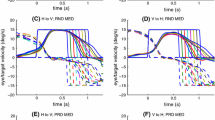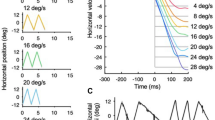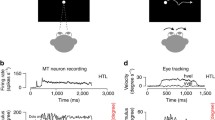Abstract
Information about the future trajectory of a visual target is contained not only in the history of target motion but also in static visual cues, e.g., the street provides information about the car’s future trajectory. For most natural moving targets, this information imposes strong constraints on the relation between velocity and acceleration which can be exploited by predictive smooth pursuit mechanisms. We questioned how cue-induced predictive changes in pursuit direction depend on target speed and how cue- and target-induced pursuit interact. Subjects pursued a target entering a ±90° curve and moving on either a homogeneous background or on a low contrast static band indicating the future trajectory. The cue induced a predictive change of pursuit direction, which occurred before curve onset of the target. The predictive velocity component orthogonal to the initial pursuit direction started later and became faster with increasing target velocity. The predictive eye acceleration increased quadratically with target velocity and was independent of the initial target direction. After curve onset, cue- and target-induced pursuit velocity components were not linearly superimposed. The quadratic increase of eye acceleration with target velocity is consistent with the natural velocity scaling implied by the two-thirds power law, which is a characteristic of biological controlled movements. Comparison with linear pursuit models reveals that the ratio between eye acceleration and actual or expected retinal slip cannot be considered a constant gain factor. To obey a natural velocity scaling, this acceleration gain must linearly increase with target or pursuit velocity. We suggest that gain control mechanisms, which affect target-induced changes of pursuit velocity, act similarly on predictive changes of pursuit induced by static visual cues.








Similar content being viewed by others
References
Baloh RW, Yee RD, Honrubia V, Jacobson K (1988) A comparison of the dynamics of horizontal and vertical smooth pursuit in normal human subjects. Aviat Space Environ Med 59:121–124
Barnes GR, Asselman PT (1991) The mechanism of prediction in human smooth pursuit eye movements. J Physiol 439:439–461
Barnes GR, Wells SG (1999) Modelling prediction in ocular pursuit: the importance of short-term storage. In: Becker W, Deubel H, Mergner T (eds) Current oculomotor research: physiological and psychological aspects. Plenum press, New York, pp 97–107
Barnes GR, Barnes DM, Chakraborti SR (2000) Ocular pursuit responses to repeated, single-cycle sinusoids reveal behavior compatible with predictive pursuit. J Neurophysiol 84:2340–2355
Becker W, Fuchs AF (1985) Prediction in the oculomotor system: smooth pursuit during transient disappearance of a visual target. Exp Brain Res 57:562–575
Bennett SJ, Barnes GR (2006) Smooth ocular pursuit during the transient disappearance of an accelerating visual target: the role of reflexive and voluntary control. Exp Brain Res 175:1–10
van den Berg AV, Collewijn H (1987) Voluntary smooth eye movements with foveally stabilized targets. Exp Brain Res 68:195–204
Carey MR, Lisberger SG (2004) Signals that modulate gain control for smooth pursuit eye movements in monkeys. J Neurophysiol 91:623–631
Churchland MM, Lisberger SG (2001) Experimental and computational analysis of monkey smooth pursuit eye movements. J Neurophysiol 86:741–759
Churchland AK, Lisberger SG (2002) Gain control in human smooth-pursuit eye movements. J Neurophysiol 87:2936–2945
Collewijn H, Tamminga EP (1984) Human smooth and saccadic eye movements during voluntary pursuit of different target motions on different backgrounds. J Physiol 351:217–250
de’Sperati C, Viviani P (1997) The relationship between curvature and velocity in two-dimensional smooth pursuit eye movements. J Neurosci 17:3932–3945
de Hemptinne C, Lefevre P, Missal M (2006) Influence of cognitive expectation on the initiation of anticipatory and visual pursuit eye movements in the rhesus monkey. J Neurophysiol 95:3770–3782
Dera T, Boening G, Bardins S, Schneider E (2006) Low-latency video tracking of horizontal, vertical, and torsional eye movements as a basis for 3DOF realtime motion control of a head-mounted camera. In: Proceedings of the IEEE international conference on systems, man and cybernetics
Epelboim J, Kowler E (1993) Slow control with eccentric targets: evidence against a position-corrective model. Vis Res 33:361–380
Fisher RA (1925) Theory of statistical estimation. Proc Cambridge Philos Soc 22:700–725
Fisher RA (1966) The design of experiments, 8th edn. Oliver and Boyd, London
Flash T, Hochner B (2005) Motor primitives in vertebrates and invertebrates. Curr Opin Neurobiol 15:660–666
Gauthier GM, Vercher JL, Mussa IF, Marchetti E (1988) Oculo-manual tracking of visual targets: control learning, coordination control and coordination model. Exp Brain Res 73:127–137
Hays AV, Richmont BJ, Optican LM (1982) A unix-based multiple process system for real-time data acquisition and control, vol 2. Wescon Conf Proc, pp 100–105
Howard IP (1997) Interactions within and between the spatial senses. J Vestib Res 7:311–345
Ivanenko YP, Grasso R, Macellari V, Lacquaniti F (2002) Two-thirds power law in human locomotion: role of ground contact forces. Neuroreport 13:1171–1174
Jarrett CB, Barnes G (2002) Volitional scaling of anticipatory ocular pursuit velocity using precues. Brain Res Cogn Brain Res 14:383–388
Keating EG, Pierre A (1996) Architecture of a gain controller in the pursuit system. Behav Brain Res 81:173–181
Kowler E (1989) Cognitive expectations, not habits, control anticipatory smooth oculomotor pursuit. Vis Res 29:1049–1057
Kowler E, McKee SP (1987) Sensitivity of smooth eye movement to small differences in target velocity. Vis Res 27:993–1015
Lacquaniti F, Terzuolo C, Viviani P (1983) The law relating the kinematic and figural aspects of drawing movements. Acta Psychol (Amst) 54:115–130
Lazzari S, Vercher JL, Buizza A (1997) Manuo-ocular coordination in target tracking. I. A model simulating human performance. Biol Cybern 77:257–266
Lisberger SG, Fuchs AF (1978) Role of primate flocculus during rapid behavioral modification of vestibuloocular reflex. I. Purkinje cell activity during visually guided horizontal smooth-pursuit eye movements and passive head rotation. J Neurophysiol 41:733–763
Madelain L, Krauzlis RJ (2003) Effects of learning on smooth pursuit during transient disappearance of a visual target. J Neurophysiol 90:972–982
Pierrot-Deseilligny C, Milea D (2005) Vertical nystagmus: clinical facts and hypotheses. Brain 128:1237–1246
Rashbass C (1961) The relationship between saccadic and smooth tracking eye movements. J Physiol 159:326–338
Robinson DA (1971) Models of oculomotor neural organisations. In: Bach-yRita P, Collins CC (eds) The control of eye movements. Academic, New York, pp 519–538
Robinson DA, Gordon JL, Gordon SE (1986) A model of the smooth pursuit eye movement system. Biol Cybern 55:43–57
Saling LL, Phillips JG (2005) Variations in the relationship between radius of curvature and velocity as a function of joint motion. Hum Mov Sci 24:731–743
Schneider E, Dera T, Bard K, Bardins S, Boening G, Brand T (2005) Eye movement driven head-mounted camera: it looks where the eyes look. IEEE Int Conf Syst Man Cybern 3:2437–2442
Schwartz JD, Lisberger SG (1994) Initial tracking conditions modulate the gain of visuo-motor transmission for smooth pursuit eye movements in monkeys. Vis Neurosci 11:411–424
Vercher JL (2006) Perception and synthesis of biologically plausible motion: from human physiology to virtual reality. Lect Notes Comput Sci 3881:1–12
Walker MF, Zee DS (2005) Asymmetry of the pitch vestibulo-ocular reflex in patients with cerebellar disease. Ann N Y Acad Sci 1039:349–358
Yasui S, Young LR (1975) Perceived visual motion as effective stimulus to pursuit eye movement system. Science 190:906–908
Zhang Y, Partsalis AM, Highstein SM (1995) Properties of superior vestibular nucleus flocculus target neurons in the squirrel monkey. I. General properties in comparison with flocculus projecting neurons. J Neurophysiol 73:2261–2278
Acknowledgments
We thank T. Dera and the Bavarian Research Foundation (FORBIAS) for development and interactive support in the video-oculography, and Mrs. J. Benson for her help in copyediting the manuscript. The study was supported by a grant of the Deutsche Forschungsgemeinschaft (DFG-GRK 1091: “Orientation and Motion in space”).
Author information
Authors and Affiliations
Corresponding author
Appendix
Appendix
In this appendix we analyze pursuit systems that are able to generalize their response to a target moving along a fixed path at a variety of target velocities. Proper generalization is here defined by the property that the position error is, for any given target trajectory, invariant to temporal scaling of target motion. It will be shown that this ability to generalize across different target speeds implies a quadratic relation between target speed and the acceleration generated by the pursuit system. For simplicity we first (in Appendix 1) restrict the consideration to constant tangential velocities, which is a quite natural situation when the movement of a target is diverted by passive constraints such as borders of a mechanically defined path. In Appendix 2, we generalize the conclusion to a certain type of scaling of tangential velocities that change along the target path. It is important to note that this type of scaling is compatible with the type of velocity scaling that is, according to the two-thirds power law, applied in natural biologically controlled motion. Finally, in Appendix 3, we show that a simple 2D velocity servo controller that has the ability to generalize across different target velocities as defined above must increase its feed-forward gain linearly with the tangential target velocity.
Appendix 1: Constant tangential velocity
Let \(\underline{{\dot{p}}} (t,\,v_{0})\) be the 2D velocity of the target moving with constant tangential velocity v 0 along a fixed path \(\underline{q} (l),\) parameterized according to its path length l. Moving with the velocity v 0, the target trajectory \(\underline{p} (t,\,v_{0})\) can then be computed by \(\underline{p} (t,\,v_{0}) = \underline{q} (v_{0} \cdot t).\)
Using the scaling factor \(a: = \frac{v}{{v_{0}}},\) we can now compute the 2D target position and velocity for any other tangential target velocity v as follows:
Differentiating two times with respect to time (t) yields
This means that changes of the tangential velocity result only in temporal scaling of the 2D-position, but in both temporal and metric scaling of the 2D-velocity. Invariance of the position error to changes of the tangential target velocity implies that the position output \(\underline{x} (t,v)\) of a pursuit system is scaled in the same way as \(\underline{p} (t,\,v).\) Thus, for an invariant position error, we obtain the following relationship for the position output:
By differentiating this equation two times with respect to time, we obtain
Thus, invariance of the position error to changes of the tangential target velocity implies that the output velocity \(\underline{{\dot{x}}}\) is scaled linearly, and the output acceleration \(\underline{{\ddot{x}}}\) is scaled quadratically with the tangential target velocity v 0. This holds for any system generating a response x following the input p, not only for the velocity servo shown in Fig. 8, and corresponds exactly to the velocity dependence of the cue-induced, predictive pursuit change (see Fig. 7).
Appendix 2: Time-dependent tangential velocity
If the tangential target velocity is not a constant, but changes along the target path as in our experiment, it is obvious that the derivation shown above will not hold for any change of the time course of the tangential velocity, because any arbitrary change cannot uniquely be described by a single scaling factor a. However, this section shows that the conclusion of (a) still holds for arbitrary time courses of the tangential velocity and arbitrary target paths, when they are subject to a certain type of velocity scaling. The following condition for the scaling of the tangential velocity is sufficient: The position of the target measured along its path D(t,v) and the tangential velocity V(t,v) must fulfill a differential equation of the type
with any function h(D) that meets the two following restrictions
-
1.
h(D = 0) = 1, and
-
2.
Eq. 6 must have a unique solution.
The constant parameter v is the tangential velocity at the beginning of the path, it was used in our experiment to specify the target velocity. It is easy to see that the trajectories generated on the basis of the two-thirds power law applied in our experiment (Eq. 2) meet this differential equation, because in Eq. 2, the factor K is proportional to the velocity at the beginning of the curve, and the factor \({\left(\frac{r}{{1 + \alpha \cdot r}} \right)}^{{1 - \beta}}\) can for any path be expressed as a function of D. When solving equation 6 by integration
substitution of a· u by y leads to
showing that
With these properties, we obtain for the 2D-position of the target:
These equations show that the 2D target position complies with the same type of velocity scaling as already found for changes of constant tangential velocity in Eq. 4a. Because this scaling type is a characteristic of the two-thirds power law describing natural movements, we call this type “natural” velocity scaling. In analogy to the last paragraph, it follows from Eq. 4a that a position error that is invariant to natural velocity scaling according to Eq. 6 implies a quadratic relation between target speed and the output acceleration of the system.
3. An implication of scaling invariance in simple velocity servos and other linear systems
Let \(\underline{{\dot{x}}} (t,\,v_{0})\) be the velocity output of a simple velocity servo (Fig. 8) in response to the velocity input \(\underline{{\dot{p}}} (t,\,v_{0}).\) This velocity output satisfies the following differential equation:
We assume that the gain depends on the tangential velocity v 0 with an unknown function g(v 0). The goal of the following derivation is to identify this gain controller under the constraint that the position error of the servo is invariant to the natural velocity scaling described in (a) and (b). Thus, we assume that the servo output satisfies Eqs. (5a) and (5b).
We set up the differential equation of the velocity servo for any arbitrary tangential velocity v,
and rewrite it using Eqs. 4a, 4b and 5a, 5b:
After dividing by a 2 we obtain
Since the differential equation of the original servo Eq. 7 holds for any time, we can replace t by a· t in Eq. 7. This yields
Finally, by inserting Eq. 9 in Eq. 8, we see that the modified servo leading to the same position error as the original one is identified by
\(g(v) = a \cdot g(v_{0}) = \frac{v}{{v_{0}}} \cdot g(v_{0}),\) i.e., the servo gain must be adjusted proportionally to the tangential target velocity in order to make its position error invariant to natural velocity scaling.
Using the Laplace theory of linear differential equations, we can easily verify that the accuracy of any linear system characterized by the transfer function F(s) (where s denotes the complex frequency) is invariant to natural velocity scaling, only if F(s) depends on the target velocity in a very specific way. Given that the input (p(t,v)) and output signals (x(t,v)) of the system are scaled according to Eqs. 4a and 5a, the corresponding Laplace-transformed functions are scaled as follows:
Since in the Laplace domain the input–output relation is given by a multiplication,
inserting Eq. 10 in Eq. 11 reveals the required scaling property of the transfer function F:
Thus, the invariance of the accuracy of the system to natural velocity scaling requires frequency scaling of the Laplace transfer function. Since such frequency-scaling involves a dynamic change of the coefficients of the linear differential equations defining the transfer function, invariance to natural velocity scaling cannot be achieved by any time-invariant linear system. Applying Eq. 12 to the Laplace transfer function of the velocity servo shown in Fig. 8 reveals that this example is a special case of the more general formulation of Eq. 12. If the integrator gain is assumed to be unity at target velocity v 0, the transfer function of the servo becomes
To achieve invariance of the accuracy of the servo to natural velocity scaling of the input, the complex frequency s must be divided by the scaling factor a (Eq. 12)
Since the transfer function of the integrator equals \(\frac{1}{s},\) dividing s by a is identical with multiplication of the integrator gain with a.
Rights and permissions
About this article
Cite this article
Ladda, J., Eggert, T., Glasauer, S. et al. Velocity scaling of cue-induced smooth pursuit acceleration obeys constraints of natural motion. Exp Brain Res 182, 343–356 (2007). https://doi.org/10.1007/s00221-007-0988-y
Received:
Accepted:
Published:
Issue Date:
DOI: https://doi.org/10.1007/s00221-007-0988-y




